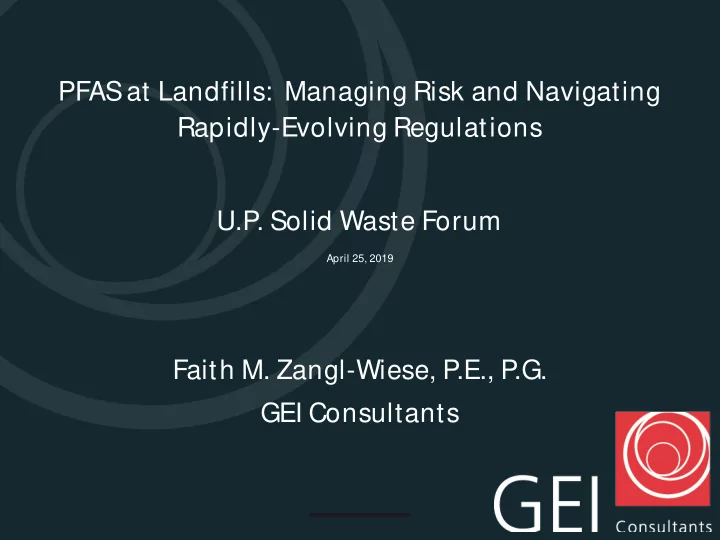

PFAS at Landfills: Managing Risk and Navigating Rapidly-Evolving Regulations U.P . Solid Waste Forum April 25, 2019 Faith M. Zangl-Wiese, P .E., P .G. GEI Consultants
AGENDA 1 Introduction to PFAS 2 PFAS Health Effects and Regulations 3 PFAS Sampling and Laboratory Analysis Considerations Divider Slide 4 Landfill Considerations 5 Recommended Resources
AGENDA 1 Introduction to PFAS Divider Slide
What are Per- and Polyfluoroalkyl Substances (PFAS)? • Large class of chemicals with unique properties • Extremely persistent and mobile in the environment • Used in a wide variety of products • Nearly ubiquitous in nature • Found even in remote places
A brief history of PFAS First detection in First detection in First detection in general environmental factory workers population samples PFAS Development Time Period 1930s 1940s 1950s 1960s 1970s 1980s 1990s 2000s Non-Stick Waterproof PTFE Invented Coatings Fabrics Stain and water Firefighting PFOS Initial Production resistant Foam products US Reduction of PFOS, PFOA, PFOA Initial Production Protective Coatings PFNA PFNA Initial Production Architectural Resins Predominant form Fluorotelomers Initial Production Firefighting Foams of firefighting foam Fluoro- Dominant Process Electrochemical fluorination telomerization Pre-Invention of Chemistry Initial chemical synthesis/ production Commercial products introduced and used 2016: USEPA set lifetime health advisory of 70 parts per trillion (ppt) for PFOA and PFOS in drinking water Source: ITRC
(or GenX) Source: ITRC Naming Conventions and Physical Chemical Properties Fact Sheet
Perfluoroalkyl substance characteristics • Fully fluorinated • Extremely stable • Resistant to: • Chemicals • Heat • Water • Oils Source: ITRC
Polyfluoroalkyl substance characteristics (“ precursors” or “GenX” ) • Partially-fluorinated • Non-fluorine atom (usually H or O) attached to at least one, but not all, of the carbons in the alkane chain • Creates a “weak link” susceptible to biotic or abiotic degradation (becoming a perfluoroalkyl substance) • Example: Can easily degrade to Source: ITRC Naming Conventions Fact Sheet
AGENDA 2 PFAS Health Effects and Regulations Divider Slide
PFAS Health Effects • Most studies have focused on PFOA and PFOS • PFOA and PFOS • Animal (documented evidence) • Affects liver, immune system, development, endocrine, reproduction • Humans (possible negative links) • Liver (cholesterol) • Immune system (decreased vaccination response, asthma) • Development (birth weight) • Reproduction (decreased fertility) • Cardiovascular system (pregnancy-induced hypertension) • Cancer (testicular, kidney) • No known studies on effects of PFAS bioaccumulation • PFAS is known to be attracted to proteins in the human body • Bioaccumulation prediction is more complicated than for other contaminants
GROUNDWATER REGULATORY STANDARDS Source: ITRC
AGENDA 3 PFAS Sampling and Laboratory Analysis Considerations Divider Slide
PFAS Sampling Considerations • Main concern is with cross-contamination of PFAS in the sampling environment • PFAS are ubiquitous • Low (i.e. ppt) standards • Much of our typical sampling equipment and items in the sampling environment contain or may contain PFAS • Little published research on how certain materials may affect sample results • Refer to MI EGLE PFAS Sampling Guidance for appropriate and prohibited materials for sampling and personal protection • Conservative approach is recommended • When in doubt, collect field, equipment, trip blanks • Also advisable to collect sample duplicates
Formally-established PFAS Laboratory Analysis Standards • EPA Method 537.1 Rev 1.1 • Drinking water method last updated November 2018 • Includes 18 PFAS analytes • Requires Field Reagent Blank for additional QA/QC • ISO Method 25101 • Method for unfiltered samples of drinking water, groundwater, and surface water • Used for PFOS and PFOA • ASTM D7979 • Used in surface water, sludge, and wastewater for select PFAS • ASTM D7968 • Used for perfluorinated substances (not exhaustive PFAS list) • “Quick and dirty” method
PFAS Laboratory Analysis to be Established • Some labs have “Modified” EPA Method 537 • Includes isotope dilution, not typically sanctioned by EPA • Used for other media (i.e. groundwater, soil, etc.) • Requires Field Reagent Blank for additional QA/QC • EPA working on additional PFAS methods for release in 2019 • EPA 8237: non-drinking water, 24 PFAS compounds • EPA 8238: non-drinking water/POTW influent/biosolids/soils/DoD sites, 24 PFAS + GenX • New drinking water method for shorter chain PFAS outside EPA Method 537 Scope
AGENDA Divider Slide 4 Landfill Considerations
PFAS in Landfills • Sources • PFAS-impacted industrial waste • Sewage sludge from wastewater treatment facilities • Waste from site mitigation • PFAS-bearing consumer wastes • Any industrial, commercial, and consumer products landfilled since the 1950s • PFAS composition and concentration • Shorter-chain PFAS tends to dominate • Concentration depends on type of landfill, waste stream accepted, and local industries
Source: Michigan EGLE, September 2018
Landfill Considerations • Lined or unlined? • Impacts are harder to control in an unlined landfill • What material is used for daily cover or alternate daily cover? • Sludge, sludge-derived products, shredded automotive parts, spray-on foams may contain PFAS • How is the leachate processed? • WWTP is common, but WWTP technologies are generally ineffective at treating PFAS or might exacerbate the issue • Age of waste? • PFAS will be released at slow but steady rates (i.e. decades) following initial placement • May take PFAS several years to reach leachate
AGENDA Divider Slide 5 Recommended Resources
Recommended Resources and References • ITRC Fact Sheets on PFAS • Great for PFAS background, evolving technologies, sampling and analysis, etc. • Regulations fact sheet is updated every 6 weeks • MI EGLE PFAS Sampling Guidance • Great for allowable sampling and analysis practices • MI EGLE PFAS Website • Free webinars • USEPA PFAS Website • Qualified environmental professionals
Uncertainties and Evolving Policies • Toxicity and risk assessment • Regulations • Sampling techniques • Analysis procedures • Fate and transport • Treatment • Especially when multiple contaminants are present • Long term efficacy
Thank you! Faith M. Zangl-Wiese Email: fzanglwiese@geiconsultants.com Office: (920) 471-4961
Questions?
Recommend
More recommend